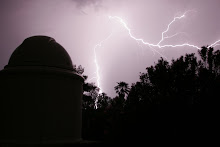It's a nice clear night so far in Tucson. I went out to open the roof on the observatory, and could not resist the urge to stop and enjoy the night sky for a little while.
Although most of us think of the stars as a bunch of little white points of light, they can actually be quite colorful for anyone who takes the time to observe them carefully. These winter nights provide an excellent opportunity to view some nice red objects. When I looked East this evening, I was immediately struck by the 3 bright red points of light that stand out in the crowd. The lowest, and brightest, is the Angry Red Planet Mars. A bit higher and to the South is the amazing Red Supergiant Betelgeuse, one of the members of the dramatic constellation of mighty Orion. Farther up lies deep red Aldebaran, the leader of the v-shaped Hyades cluster and an important component of the sharp horns of Taurus the Bull.
Looking deeper into space, one finds red over and over. Most nebulae glow red as they emit photons created from the ionization of Hydrogen, which makes up the vast majority of the known universe. Interstellar dust and gas creates a reddening effect on many of the objects we observe.
This image is a wide-field rendition of the Christmas Tree Cluster and Cone Nebula region. The dominant red color shows relatively dense regions of hydrogen gas, commony called HII regions. Click here for a better view of the image and more information about how the image was obtained.
Right now my telescope and camera are obtaining data for another HII region, known as IC 2177 and commonly called the Seagull Nebula. I suspect the humidity will force me to close the observatory before midnight, since we have had considerable rain in the past few weeks, but for now my scope and I are enjoying our amazing universe.
Monday, February 8, 2010
Subscribe to:
Post Comments (Atom)


No comments:
Post a Comment